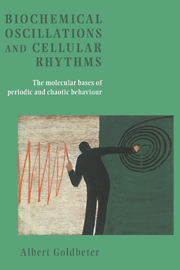Book contents
- Frontmatter
- Contents
- Foreword to the English edition by Michael Berridge
- Foreword to the French edition by Ilya Prigogin
- Preface
- 1 Introduction
- Part I Glycolytic oscillations
- Part II From simple to complex oscillatory behaviour
- Part III Oscillations of cAMP in Dictyostelium cells
- 5 Models for the periodic synthesis and relay of cAMP signals in Dictyostelium discoideum amoebae
- 6 Complex oscillations and chaos in the cAMP signalling system of Dictyostelium
- 7 The onset of cAMP oscillations in Dictyostelium as a model for the ontogenesis of biological rhythms
- Part IV From cAMP signalling in Dictyostelium to pulsatile hormone secretion
- Part V Calcium oscillations
- Part VI The mitotic oscillator
- Part VII Circadian rhythms
- References
- Index
7 - The onset of cAMP oscillations in Dictyostelium as a model for the ontogenesis of biological rhythms
Published online by Cambridge University Press: 26 February 2010
- Frontmatter
- Contents
- Foreword to the English edition by Michael Berridge
- Foreword to the French edition by Ilya Prigogin
- Preface
- 1 Introduction
- Part I Glycolytic oscillations
- Part II From simple to complex oscillatory behaviour
- Part III Oscillations of cAMP in Dictyostelium cells
- 5 Models for the periodic synthesis and relay of cAMP signals in Dictyostelium discoideum amoebae
- 6 Complex oscillations and chaos in the cAMP signalling system of Dictyostelium
- 7 The onset of cAMP oscillations in Dictyostelium as a model for the ontogenesis of biological rhythms
- Part IV From cAMP signalling in Dictyostelium to pulsatile hormone secretion
- Part V Calcium oscillations
- Part VI The mitotic oscillator
- Part VII Circadian rhythms
- References
- Index
Summary
Biological rhythms occur only under precise conditions, and variations in a control parameter can bring about their disappearance. In a symmetrical manner, the variation of such a parameter can lead to the appearance of a rhythm in the course of development. There is no example as yet where the molecular basis of the ontogenesis of a biological rhythm is known in detail. The rhythm of intercellular communication in the slime mould Dictyostelium discoideum provides us with a prototype for the study of this question.
Appearance of excitability and oscillations in the course of development of Dictyostelium amoebae
Studies of aggregation of D. discoideum amoebae on agar have shown that cells are capable of relaying an artificial cAMP signal applied iontophoretically by means of a pipette, before being able to produce sustained oscillations in an autonomous manner (Robertson & Drage, 1975; Gingle & Robertson, 1976). These spontaneous oscillations of cAMP occur only a few hours after the beginning of starvation.
Studies of D. discoideum cells in suspensions confirm this observation (Gerisch et al., 1979). At the beginning of starvation, the amoebae are unable to amplify cAMP signals. Some 2 h later, the amoebae amplify cAMP pulses whose amplitude exceeds a threshold. Four hours after the beginning of starvation, spontaneous oscillations arise and are maintained for 3 h before giving way to excitable behaviour (fig. 7.1). During the hours preceding starvation, the amoebae thus undergo successive transitions that modify the dynamic properties of the signalling system that controls intercellular communication. The sequence of developmental transitions leads from the absence of excitability to relay, and from relay to autonomous oscillations of cAMP.
- Type
- Chapter
- Information
- Biochemical Oscillations and Cellular RhythmsThe Molecular Bases of Periodic and Chaotic Behaviour, pp. 284 - 300Publisher: Cambridge University PressPrint publication year: 1996



